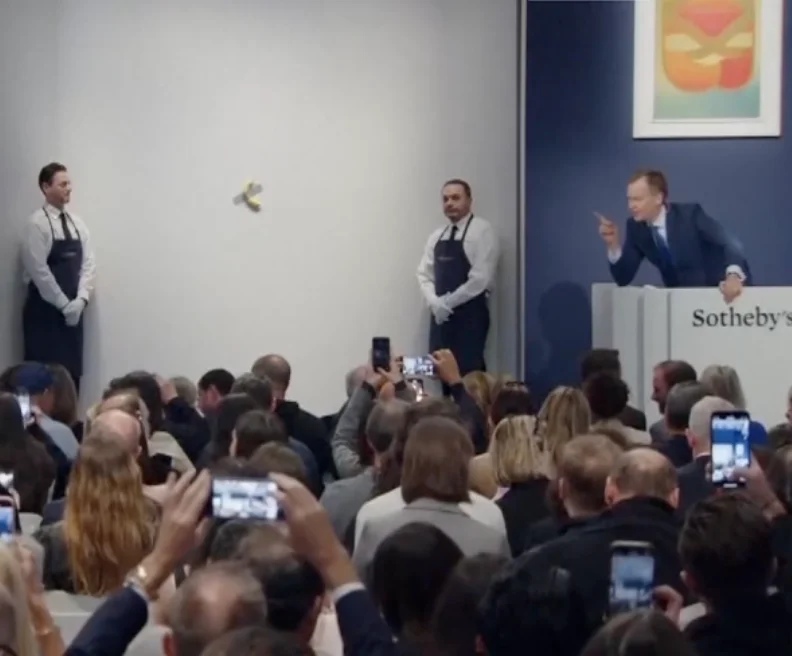In the world of extravagant purchases, million-dollar mansions, luxury cars, and rare art pieces often grab headlines. But one recent acquisition has sparked confusion and curiosity worldwide.
It wasn’t a gem-encrusted artifact or a renowned painting it was a banana. The story of this humble fruit, however, is far more intriguing than it appears.
The journey of this banana began on the streets of Manhattan, New York. Shah Alam, a 74-year-old fruit vendor, sold it for less than a dollar from his modest stand near Sotheby’s auction house.

Alam earns $12 an hour selling bananas at 20 cents each, or under a dollar per bunch. Unbeknownst to him, one of his bananas was about to make history.
This seemingly ordinary fruit caught the eye of Italian artist Maurizio Cattelan. Known for his provocative works, Cattelan transformed the banana into a conceptual art piece titled Comedian.
The artwork, consisting of a banana duct-taped to a wall, first debuted at Art Basel in Miami Beach in 2019. It quickly ignited debates about the value and meaning of art.
During its initial showing, Comedian sold for more than $120,000. This year, Cattelan’s creation returned to the spotlight at Sotheby’s auction house.

The banana attracted global attention, with seven bidders vying for the artwork. It was cryptocurrency mogul Justin Sun who eventually won, bidding an astonishing $6.2 million (£4.88 million).
Sun, the founder of TRON, later admitted his disbelief upon securing the piece. “In the first 10 seconds after I won the bid, I was in shock,” he shared.
Within moments of the realization, Sun decided to give the artwork an unprecedented twist. He envisioned turning the banana’s story into something even bigger.

To understand Sun’s vision, reporters and influencers gathered at the luxurious Peninsula Hotel in Hong Kong. Sun’s actions that day left everyone stunned.
Standing in front of a duct-taped banana displayed on a wall, Sun delivered a speech. He praised conceptual art and compared its innovation to blockchain and NFTs.
“Most of its objects and ideas exist as intellectual property and on the internet, as opposed to something physical,” he explained. His words built anticipation for what came next.
Sun then did the unthinkable—he ate the £5 million banana in front of the gathered audience. “It’s much better than other bananas,” he declared.

He described the act as his contribution to the artwork’s history. “Eating it at a press conference can also become a part of the artwork’s history,” he remarked.
The original seller of the banana, Shah Alam, was overcome with emotion upon learning its value. “I am a poor man,” Alam said. “I have never seen this kind of money.”
In response, Sun pledged to buy 100,000 bananas from Alam’s stand in Manhattan. He planned to distribute them globally as a gesture celebrating the link between art and life.
While applauded for his generosity, Alam expressed concern over the logistical challenges of fulfilling such a massive order. Procuring the bananas and transporting them posed significant hurdles.

“There’s not any profit in selling bananas,” Alam explained, highlighting his slim earnings after sharing profits with his stand owner and six employees. The order offered little financial gain.
Attendees at the event received duct-taped bananas as souvenirs of the occasion. “Everyone has a banana to eat,” Sun announced, blending humor with the conceptual art’s theme.
The artwork itself came with a certificate of authenticity and instructions for replacing the banana when it decayed. Sun now owns the rights to recreate Comedian using any banana.

Despite the debates over whether duct-taping a banana to a wall constitutes art, Sun’s actions have ensured its lasting legacy. The £5 million banana is now part of a global conversation.
For Sun, this was more than an extravagant snack—it was a statement. By eating the banana, he connected the everyday to the extraordinary, making art history in a way no one expected.
Featured Image Credit: (Youtube/ @Associated Press)





